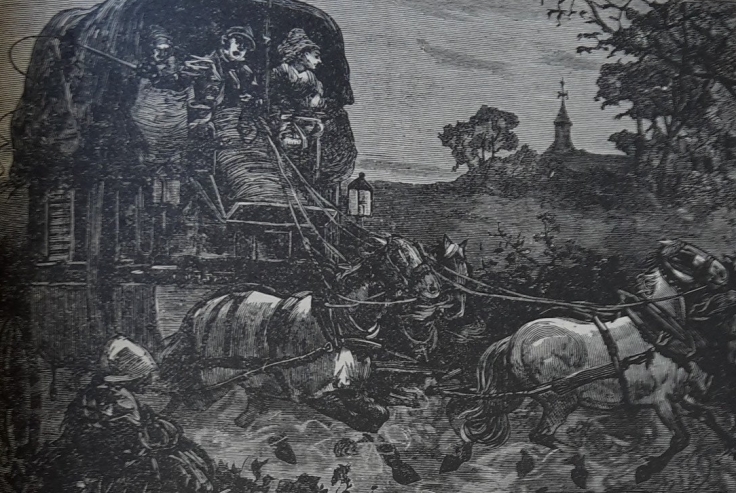
On 2 July 1844 Dickens and his family set off from Dover for their journey to Genoa – it would take them 18 days to arrive there. For us as modern readers this timescale is either a heavenly idea of a leisurely tour, or a nightmarish vision of the ultimate travel delay; but from the perspective of Dickens and his contemporaries it was a triumph of modern transport and the increasing accessibility of the continent. On 7 April 1860 Dickens published an article ‘Travelling Abroad‘ in which he reflects on the rapid pace of travel:
I GOT into the travelling chariot—it was of German make, roomy, heavy, and unvarnished—I got into the travelling chariot, pulled up the steps after me, shut myself in with a smart bang of the door, and gave the word “Go on!”
Immediately, all that W. and S.W. division of London began to slide away at a pace so lively, that I was over the river, and past the Old Kent-road, and out on Blackheath, and even ascending Shooter’s Hill, before I had had time to look about me in the carriage, like a collected traveller.
Dickens always notes how fast it is, not how slow. In A Flight (30 August 1851) Dickens marvelled at the train which now rushed him to Paris, and suggests ‘I have but to sit here
thinking as idly as I please, and be whisked away.’ Travel was no longer the arduous ordeal reserved for explorers that it used to be, but a swift experience in which the countryside became a blur between established stops.
The exact details of Dickens’ journey over the next couple of weeks are reliant upon letters to John Forster sent from Marseilles and Genoa in mid-July. The uncertainty over the dates is dues to the fact that the letters themselves don’t survive, other than as recollections in Forster’s biography of Dickens published after his death. Dickens had written his letters home with the idea that they would form the basis of a travel narrative (Pictures from Italy,eventually published in 1846), so for his biography Forster declined to quote the letters in full on the grounds that details could be found in Pictures instead. While this is true for a lot of Dickens’ escapades in Italy, it does unfortunately leave us with several blanks, as in the case of the journey there.
We know the Dickens family would have gone through Boulogne and Paris, and as the editors of the Pilgrim letters point out, the popular route between those two destinations at that time would have taken Dickens through Abbeville and Beauvais. Pictures then tells us in more detail of the journey after Paris, which they depart on the Sunday (7 July), going through Sens, Avallon and Chalons by road, then steamboat to Lyons, then back on the road to Aix and Marseilles (arriving 14 July), from where a boat would then take them round the coast to Genoa.
Admittedly, by the standard of Dickens’ time, this was a leisurely pace, with several stops on the way, and the journey could have been done quicker. In Pictures he writes in Rome of the Mr and Mrs Davis who ‘had probably been brought from London in about nine or ten days’. Again, what seems like a rather convoluted journey to us was being celebrated as a new age of travel, with advances in transport, communication and travel guides making foreign climes ever more accessible. Thus while the Davis’ party arrived in Rome in little over a week, ‘Eighteen hundred years ago, the Roman legions under Claudius, protested against being led into Mr and Mrs Davis’s country, urging that it lay beyond the limits of the world.’ For the Dickens family, leaving England on this day 175 years ago, Italy was no longer beyond the limits of the world, but a familiar tourist destination nonetheless filled with wonder and romance of the classical world. All of which we will see in time, as they did, when the eventually arrived…


Leave a comment